Living with a Falco, an All Round Experience
![]()
Living with a Falco, an All Round Experience |
|
by Stuart Gane
|
This article appeared in the June 2001 issue of the Falco Builders Letter. |
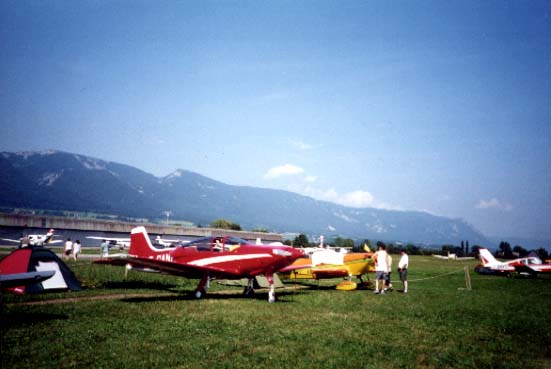
At Swiss Fly-In at Grenchen.
For my wife Vivienne and me, living with this aircraft has been an experience, which has enriched both our lives in many ways, some of which were quite unexpected. I never thought for a moment that when I set out to build a Falco in 1986 that it would have such a profound effect on us.
Yes, I knew it was a big commitment in both time and finance and being the sort of personality that I am, once embarked on such a project, I would become very focused until it was finished. I found the task of building the aircraft a most rewarding experience, I learned new skills and acquired knowledge, which has been useful in a variety of ways, although I have still to find a use for all 50 quick-release clamps.
All those days, weeks, months and years working on the Falco have rewarded us both with fun and a wealth of experiences which have made our lives so much richer that it would be hard to find any other project that would come even close to emulating what building and owning a Falco has done for us. Sometimes in most unexpected ways.
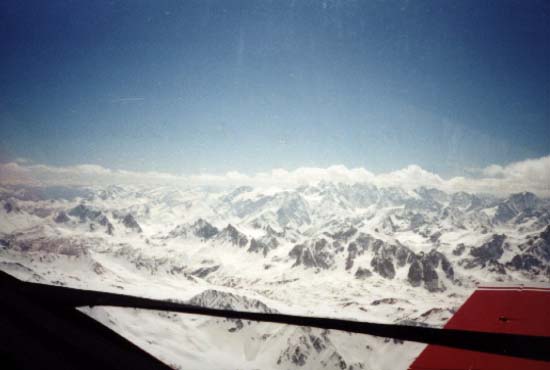
At 14500' over the Alps on the way back from Venice.
For example, it was the catalyst for us both to take up cycling as a means of keeping fit. That came about because the doctor at my annual medical warned me that there was steady increase in my weight. So, the next day I went and bought a mountain bike. Vivienne at first looked surprised when she saw me arrive home with the new bike then said she too would like to take up cycling. I have a niggling feeling she may have regretted that request. However, 18 months later we are still cycling regularly. Falcos do strange things to people.
I can recall other contributors to FBL writing about how when they arrived at a new field in their Falco, strangers would stroll over to the aircraft to ask questions or to pass on complimentary comments about the look of the machine. I too have had similar experiences. It is a very rare occasion when, on arrival for the first time at an airfield, we don't receive some complimentary comment or notice that passers-by stop and look at the Falco. As a result we have made friends in many of the countries we have visited.
Looking through my logbook since owning the Falco, we have visited 10 countries in Europe. Too many trips to recount in this article, but one of the more memorable destinations and typical of the sort of experience we have had with our aircraft was the journey from Venice's general aviation airport San Nicolo during Easter 2000. San Nicolo was the base used for the Schneider Air Races in the 1920s and early 1930s. The original tower and terminal buildings were built for Mussolini who had great plans for the airport but, like so many of his other plans, they were never realised. Today it is a very quiet field, full of memories. The main airport for Venice is Tessera across on the north side of the lagoon. A very busy place indeed, where you are required to fly accurately when flying inside its controlled airspace, if you are to avoid upsetting all those happy charter passengers, not to mention ATC.
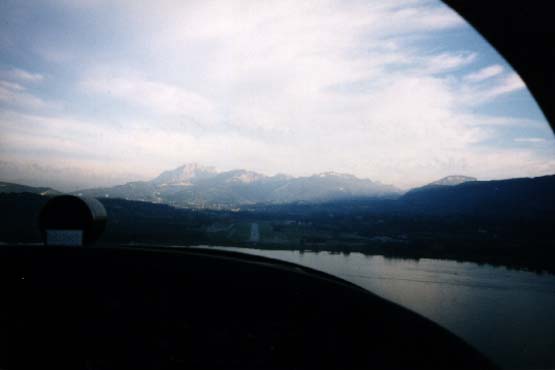
On long final for Chambery, France.
Departure from runway 06 at San Nicolo takes you directly out over the deep shipping lane in the lagoon surrounding Venice. Just as we lifted the aircraft from the grass runway, a very large ocean liner appeared, making its majestic way out of the lagoon with some tall masts threatening to scratch our paintwork. It was a close call, as we roared over the liner no more than 50' above the boats gaping funnel.
On this particular flight, we had filed to fly direct to Chambery in S.E. France, which meant a crossing of the Alps on the Italian French border. The weather was excellent for VFR flight but it did entail a crossing height at FL125.
We should have had oxygen supplies on board but as we had both flown up to 15000' the previous year in the Swiss Alps with no breathing problems, we felt confident we would be okay. I was impressed with the way the Falco performed in spite of being near gross weight when required to climb above 10,000'. The VSI was still showing an 800' climb rate at our crossing altitude.
The crossing was uneventful apart from the period when Turin ATC cleared us en-route to Geneva. For the entire crossing of approximately 15 minutes, we were unable to get a reply from Geneva. What a long period of silence that appeared to be. I checked and re-checked the radios but nothing seemed to be amiss. Eventually I concluded we were not high enough as Mt Blanc at 15,000' was between Geneva and us.
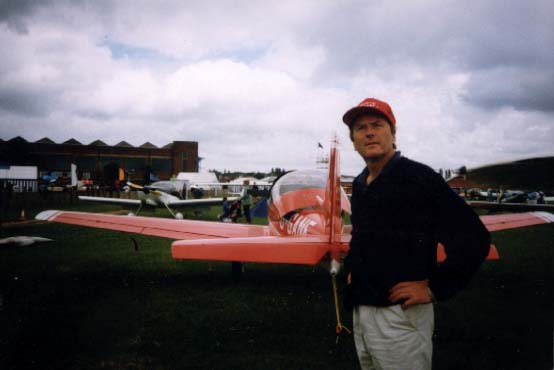
Stuart and G-GANE
The scenery as you would imagine was spectacular with blindingly white snowfields set amongst sheer-faced grey-black rock. For somebody like me who has no intentions of taking up mountaineering, this is as close as I will ever get to such foreboding but beautiful territory, unless we had an engine failure. We looked in awe at the mountain scenery but all the time our ears were tuned to the sound of the engine, which reassuringly maintained a steady note.
Eventually we were close enough to Chambery to establish radio contact for landing instructions. They must have mistaken us for some other type of aircraft, for at four miles out and still at 10,000' over the Alps we were cleared for a straight-in approach on 36. Probably a nosedive would have enabled us to make it but being the more cautious type and not wanting to explore the nether regions of control flutter, we requested an orbit to lose height at a more sedate decent. We landed with no further problems. Even the surly refueller, who made it quite obvious to us that small aeroplanes should be nailed to the ground, could not dampen our exhilaration from flying safely over such spectacular but unforgiving territory.
Until our departure the next day, the weather had been quite good but as we flew North it was increasingly obvious that the weather was closing in and we would have to divert to avoid a large weather front, which was looming ever larger and blacker every mile we flew towards it.
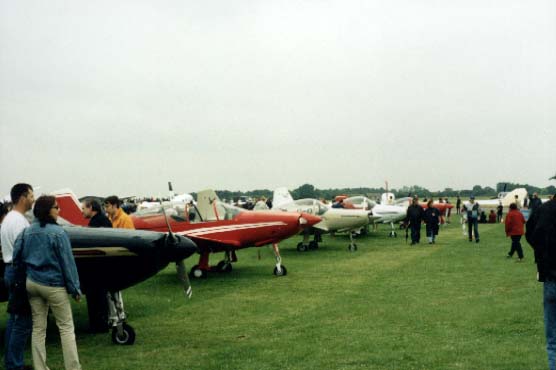
Falcos at the PFA Rally 2000
A rapid check on the map and Jeppesen for suitable fields seemed to suggest Bourges (S.W. Paris) although closed would have to be our best diversion. We landed just before a torrential storm broke on what we thought was a deserted airfield, just as we turned the engine off and began to ponder what we should do next, a Cessna 172 stopped at the entrance to the apron and the passenger climbed out, walked over to our aircraft and said he was the CFI, the field was indeed closed but, if we would like to taxi behind him up to the club hangars, we were welcome to hangar the Falco overnight free of charge.
He also arranged for a club member to ferry us to a hotel for the night. We were driven to number of hotels before we found one with a vacancy. Apparently there was a film festival on in town hence the lack of rooms. We have found on many occasions French towns always seem to have some local festivity taking place whenever we are in desperate need of accommodation. The driver was very generous with his time and petrol and would not accept any payment. However, we were only too pleased to let him borrow our mobile phone so he could let his wife know why he was so late coming home.
The hotel turned out to be rather luxurious, read expensive, with excellent food and facilities. Once settled in, our thoughts turned to two friends who had flown out of Venice the day before to visit Euro Disney.
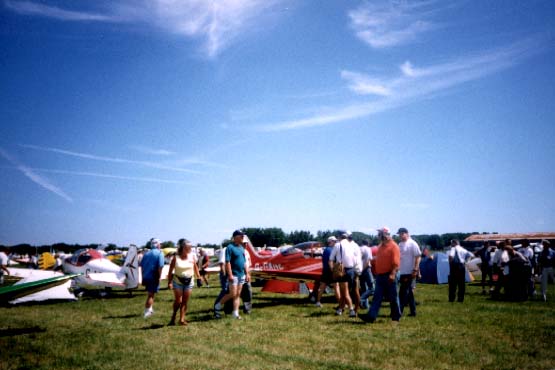
G-GANE getting a look over at RSA rally in France.
As it turned out they too had been caught by the appalling weather and were stuck in a tiny tent on a deserted grass airfield with no facilities, no food and the rain was beating down on their tent so hard we could hardly make out what they were saying. From our four-star hotel bedroom, we felt sorry for them!
The following morning it was still raining. The only way we could obtain a weather forecast for our trip home was either an expensive and possibly abortive taxi journey to the airfield or an equally expensive phone call to private aviation weather forecasting company in the UK.
We chose the company. The forecaster was a helpful character, who warned us of dire consequences if we should venture home that day, or even for the next four days! However, he stared a little harder into his crystal ball and advised us there might, just might be a small window of reasonable weather for about three hours if we left at first light, say about 5:00am the next day. Helpful.
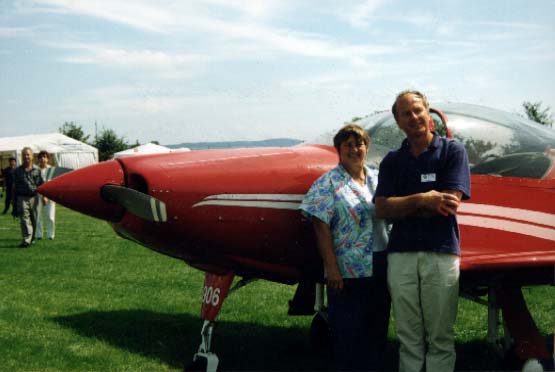
Vivienne and Stuart at Swiss Fly-In 2000
Whilst we pondered on the situation and took comfort in the surroundings of our hotel, momentarily feeling pleased that we did not have to sit out this weather out in a small tent, unlike David and Sheila. There appeared to be an easing of the rain and the sky began to lose its leaden colour. Remembering that piece of weather folklore 'rain before seven, dry before eleven' we waited and, sure enough, just after eleven the rain stopped and the low cloud began to lift.
We decided to check out of the hotel and get back to the airport. Again the CFI at the club proved what a great fellowship there is in aviation by allowing us full use of the facilities for obtaining en route forecasts. It was much more promising that our over-priced prophet of doom forecaster from the UK had predicted, and we able to fly home, only having to skirt around a large weather cell some 15 miles out from our home base.
Our experience of VFR flying in Europe and the UK tells us you can never rely on the weather to remain stable for very long, you can expect to encounter some marginal if not un-flyable weather if you go any distance. On the other hand, you get to experience flying in very different environments. You leave one country with its own particular language challenges and can land in another with a whole new linguistic challenge to be encountered. It makes you appreciate how fortunate it is to be an English-speaking pilot. Some countries in Europe can be very bureaucratic, particularly over homebuilt aircraft. In certain countries it is necessary to obtain written permission before you may fly in their airspace.
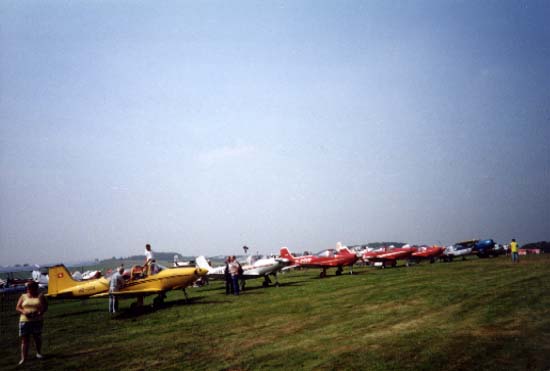
Line up of Falcos at Schaffen-Diest: Belgium 2000. Homebuilts
and factory versions.
At one time there were 12 Falcos in the line up.
Invariably the individuals you meet at the foreign fields are most welcoming and like the look of the Falco. The airplane is much admired in Europe. Amongst some of the trophies we have won is a saw, because the Falco was constructed from wood. That was from a Swedish fly-in where the organizers attempted to find an appropriate prize for each type of aircraft.
In Switzerland two years ago, we were presented with two Pilatus Turbo prop control columns each mounted in a solid billet of aluminium, far too difficult to adapt for use in the Falco. They were so heavy we had to ask a couple of English spotters if they would take them home for us by car. At the same time, we received a watch that had no numbers, only a picture of the Matterhorn mountain.
That led to such comments when asked the time as, 'half-past Matterhorn' or 'it's peak time' and so on. Last year we received two original cartoon drawings of our Falco for best homebuilt and longest distance flown, expertly drawn by a local Swiss pilot. The pilot and passenger look like two monkeys. I hope that was no reflection on our flying skills! There have been other prizes won by our aircraft, which has caused one or two of our flying friends to ask, with tongue in cheek, if we have now got a trophy cabinet.
We have both had a lot of fun flying in the Falco and hope
to continue to do so for long in to the future. Talking of the
future, we hope to fly to Italy again this Easter holiday, but
this time to Florence. And in the summer holidays Portugal is
beckoning, weather permitting, as always.
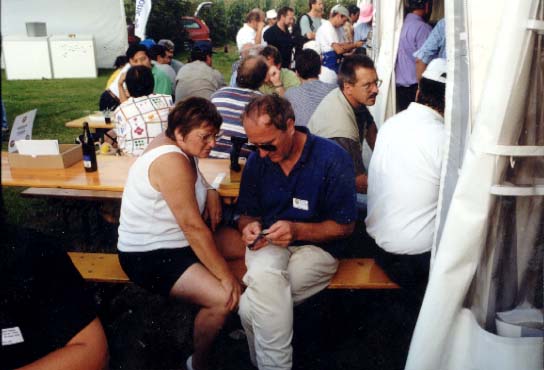
Swiss Fly-In 2000. Looking at watch awarded for longest distance
flown -- 600 nautical miles.
|
|